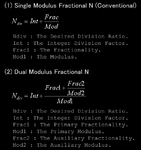pancho_hideboo
Advanced Member level 5
- Joined
- Oct 21, 2006
- Messages
- 2,847
- Helped
- 767
- Reputation
- 1,536
- Reaction score
- 733
- Trophy points
- 1,393
- Location
- Real Homeless
- Activity points
- 17,490
The averaged division ratio is calculated in the Fractional-N PLL feedback path like (1) of attached figure.
This scheme is well known.
However there is a different scheme like (2) of attached figure.
I don't know how to realize this scheme.
My questions are :
(a) What merit does this scheme have ?
A very fine frequency resolution with no residual frequency error ?
Enhanced randomnesss which can result in rare fractional spurious ?
(b) How to realize this scheme ?
Is there any document which can be helpful ?
This scheme is well known.
However there is a different scheme like (2) of attached figure.
I don't know how to realize this scheme.
My questions are :
(a) What merit does this scheme have ?
A very fine frequency resolution with no residual frequency error ?
Enhanced randomnesss which can result in rare fractional spurious ?
(b) How to realize this scheme ?
Is there any document which can be helpful ?
